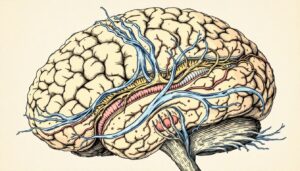Want to improve your sleep by quitting caffeine addiction, without the harsh withdrawal symptoms? This guide on how to stop caffeine addiction will show you how. From recognizing addiction signs to managing symptoms, we’ll cover all you need to know. Let’s take the first step towards a caffeine-free life.
Key Takeaways
- Caffeine addiction develops through increased tolerance and withdrawal symptoms, which indicate a dependence on the substance.
- Gradual reduction of caffeine intake, rather than abrupt cessation, is essential for minimizing withdrawal symptoms and successfully overcoming dependency.
- Long-term strategies for maintaining a caffeine-free lifestyle include a consistent routine, healthy eating, and regular physical activity to manage energy levels.
Understanding Caffeine Addiction
Caffeine is a widely consumed central nervous system stimulant, renowned for its ability to boost concentration and metabolism. It achieves this by blocking adenosine receptors in the brain, which are responsible for promoting sleepiness. Over 90% of adults in the U.S. regularly consume caffeine, averaging about 200 mg daily. Many people also drink caffeine, and this high prevalence underscores the potential for widespread dependence on caffeine research.
What starts as a pleasant habit can quickly transform into a daily necessity, leading to potential addiction. Caffeine is a psychoactive substance that alters mood and mental state, contributing to its addictive properties. Regular consumption leads to increased tolerance, meaning individuals must consume more caffeine to achieve the same effects. This cycle of needing more caffeine to function normally can lead to a significant psychological dependence and negative impact on one’s health.
Understanding the mechanics of caffeine addiction is the first step towards addressing it. The shift from casual consumption to dependence is driven by the brain’s adaptation to regular caffeine intake, necessitating a higher dosage for the same effect. Recognizing this pattern is crucial for anyone looking to quit caffeine and regain control over their daily routines. The adverse consequences of caffeine addiction can include withdrawal symptoms, disrupted sleep patterns, and increased anxiety.
What Is Caffeine Addiction?
Caffeine addiction, also known as caffeine use disorder, is a condition where an individual experiences both physical and psychological dependence on caffeine. This dependence can negatively impact daily life, relationships, and overall health. People with caffeine addiction often find it challenging to control their caffeine intake, even when they face adverse consequences.
Caffeine is a central nervous system stimulant that can make you feel more alert, energetic, and in a better mood. However, regular consumption can lead to tolerance, meaning you need to consume more caffeine to get the same effects. This can create a vicious cycle of dependence and withdrawal symptoms when you try to quit or cut back on caffeine intake.
The Food and Drug Administration (FDA) suggests that healthy adults should limit their caffeine intake to no more than 400 milligrams per day, which is roughly equivalent to four cups of coffee. However, individual tolerance to caffeine can vary significantly. Some people may experience negative effects at much lower doses, while others can consume more without any issues.
Caffeine Dependence and Tolerance
Caffeine dependence occurs when your body gets used to the constant presence of caffeine, leading to changes in brain chemistry and physical characteristics. This dependence can result in withdrawal symptoms when you reduce or stop your caffeine intake. Tolerance develops as your body becomes accustomed to caffeine’s stimulating effects, requiring you to consume more to achieve the same results.
Regular caffeine consumption can lead to physical dependence, making your body rely on caffeine to function normally. When you try to quit or cut back, you may experience withdrawal symptoms that can range from mild to severe. These symptoms can include headaches, fatigue, difficulty concentrating, and a depressed mood.
Recognizing the Signs of Caffeine Addiction
Increased caffeine tolerance to caffeine is a hallmark sign of addiction, where individuals find themselves needing more caffeine to get the same stimulating effects. This happens because regular caffeine consumption leads to chemical changes in the brain, resulting in the creation of more adenosine receptors and, consequently, increased tolerance. If you notice that your daily cups of coffee have steadily increased over time, this could be a red flag.
Withdrawal symptoms are another clear indicator of caffeine addiction. Common withdrawal symptoms include sleep disruption, migraines, irritability, and a quickened heartbeat. The most frequently reported symptom is the infamous caffeine withdrawal headache. Many individuals continue their caffeine habit primarily to avoid these unpleasant withdrawal symptoms.
Moreover, a persistent desire or unsuccessful attempts to cut down on caffeine is a significant sign of dependence. Studies have shown that 89% of participants reported a strong desire or unsuccessful efforts to reduce their caffeine intake. If you find yourself unable to quit caffeine despite wanting to, it’s essential to recognize this as a sign of caffeine dependency and take steps to address it.
Steps to Gradually Reduce Caffeine Intake
Gradually reducing caffeine intake is crucial for minimizing withdrawal symptoms and ensuring a smoother transition away from caffeine dependence. Instead of quitting cold turkey, which can lead to intensified withdrawal symptoms, a gradual reduction approach is recommended. This section will outline the key steps to help you reduce your caffeine consumption effectively.
Conducting a caffeine audit, setting realistic reduction goals, and substituting high-caffeine drinks with lower-caffeine alternatives are essential steps in this journey. Each of these steps plays a vital role in ensuring that the reduction process is manageable and sustainable.
Conduct a Caffeine Audit
The first step in reducing caffeine intake is to conduct a thorough caffeine audit. This involves tracking your daily caffeine intake to understand your consumption patterns. It’s essential to review all sources of caffeine, including coffee, tea, energy drinks, soft drinks, and even certain foods. Keeping a detailed record can help reveal unexpected sources of caffeine and enhance your awareness of how much caffeine you consume daily.
Understanding your caffeine consumption can help identify areas for reduction and set achievable goals. By knowing exactly how much caffeine you are consuming, you can make informed decisions about where to cut back and track your progress effectively. This audit serves as a foundation for the subsequent steps in your caffeine reduction journey.
Daily Caffeine Intake Patterns
Daily caffeine intake patterns can vary widely among individuals. Some people consume caffeine in moderation, while others may drink multiple cups of coffee or energy drinks throughout the day. The primary sources of caffeine can also differ, with coffee, tea, energy drinks, and chocolate being common contributors.
Research indicates that your daily caffeine intake patterns can influence your risk of developing caffeine dependence and experiencing withdrawal symptoms. Consuming large amounts of caffeine or frequently throughout the day can increase the likelihood of dependence and make withdrawal symptoms more severe.
Set Realistic Reduction Goals
Setting realistic and achievable reduction goals is crucial for a successful caffeine reduction journey. Instead of quitting caffeine abruptly, which can lead to severe withdrawal symptoms, it’s better to cut down slowly every few days. Gradually reducing caffeine intake allows your body to adjust and minimizes the likelihood of experiencing intense withdrawal symptoms.
Establishing specific timelines for reducing caffeine can help maintain motivation and track progress. For instance, medical professionals recommend stopping caffeine intake by 2 p.m. to lessen its impact on sleep. By setting these incremental goals, you can systematically reduce your caffeine dependence without overwhelming yourself.
Substitute High-Caffeine Drinks
Substituting high-caffeine drinks with lower-caffeine alternatives is a practical approach to reducing overall caffeine intake. Switching from dark roast to light roast coffee can help lower caffeine intake gradually. Additionally, incorporating a cup of coffee herbal teas can provide a flavorful alternative to high-caffeine beverages like coffee and energy drinks.
Consuming nutrient-rich foods is also essential during this transition, as they help maintain energy levels and reduce the need for caffeine. By making these substitutions, you can enjoy your favorite beverages while progressively lowering your caffeine intake.
Managing Withdrawal Symptoms
Managing withdrawal symptoms is a critical aspect of reducing caffeine intake. Common withdrawal symptoms include headaches, fatigue, mood changes, difficulty concentrating, and constipation. The most frequently endorsed symptom is the caffeine withdrawal headache. These caffeine withdrawal symptoms can last anywhere from 2 to 9 days, with the peak occurring 1 to 2 days after caffeine cessation.
To minimize these symptoms, gradually reducing caffeine intake is recommended. Additionally, staying hydrated, maintaining a healthy diet, and practicing stress-relief techniques can significantly help manage and mitigate withdrawal symptoms. These strategies will be discussed in the following subsections.
Stay Hydrated
Staying hydrated is crucial during caffeine withdrawal, as dehydration can exacerbate withdrawal symptoms and make the process more uncomfortable. Drinking water helps reduce withdrawal symptoms and boosts energy levels. Making a conscious effort to stay hydrated is vital for a smoother withdrawal experience.
In addition to water, consuming hydrating foods such as fruits and vegetables can also contribute to overall hydration. Avoiding sugary and caffeinated beverages will further support your efforts to stay hydrated and manage withdrawal symptoms effectively.
Maintain a Healthy Diet
Maintaining a healthy diet is essential during caffeine reduction. Nutritional counseling can help individuals create a balanced diet that supports energy levels without relying on excess caffeine. Eating a balanced diet rich in nutrients is crucial to support overall well-being and prevent energy crashes.
Incorporating foods high in fiber, protein, and healthy fats can provide sustained energy throughout the day. Additionally, avoiding processed foods and sugary snacks can help stabilize blood sugar levels and reduce the need for caffeine to maintain energy.
Practice Stress-Relief Techniques
Practicing stress-relief techniques is vital for managing anxiety and other withdrawal-related issues during caffeine reduction. Meditation can help center the mind and reduce stress, making it an effective technique during caffeine withdrawal. Regular physical exercise can also alleviate anxiety and improve mood, serving as a strong counter to withdrawal symptoms.
In addition to meditation and exercise, practicing deep breathing exercises can facilitate relaxation and reduce feelings of anxiety during withdrawal. By incorporating these stress-relief techniques into your daily routine, you can better manage the psychological challenges of reducing caffeine intake.
Avoiding Cold Turkey Approach
Quitting caffeine cold turkey can lead to severe withdrawal symptoms, such as headaches, fatigue, and difficulty concentrating. This abrupt approach can be challenging and may result in relapse. A more effective strategy is to gradually reduce your caffeine intake over several days or weeks.
Gradually reducing your caffeine intake helps minimize withdrawal symptoms and makes it easier to quit. This method allows your body to adjust to the decreasing levels of caffeine, reducing the risk of severe withdrawal symptoms. Patience and persistence are key when quitting caffeine, as it may take some time to adapt to new habits.
It’s also important to be aware that some people may experience a caffeine withdrawal headache, which can be painful but should not be debilitating. If your withdrawal symptoms are severe or prolonged, it’s essential to consult a doctor for guidance.
By following these strategies and understanding the nature of caffeine addiction, you can take meaningful steps towards reducing your caffeine dependence and improving your overall well-being.
Exploring Treatment Options for Severe Cases
For severe cases of caffeine addiction, exploring treatment options is essential. The World Health Organization recognized caffeine use disorder as a clinical disorder in 2012. Cognitive-behavioral therapy (CBT) is a recommended approach for treating caffeine addiction, addressing psychological triggers and developing coping strategies.
Support groups provide a beneficial environment for individuals with caffeine addiction, facilitating shared experiences and encouragement. Alternative therapies, such as mindfulness meditation and yoga, can enhance traditional treatment methods for caffeine addiction. These comprehensive treatment options offer robust support for individuals struggling with severe caffeine dependence.
Long-Term Strategies for Staying Caffeine-Free
Adopting long-term strategies is crucial for maintaining a caffeine-free lifestyle. Creating a consistent daily routine can enhance your energy levels and help manage fatigue after quitting caffeine. Incorporating healthy snacks with low sugar content can help maintain energy levels without caffeine.
Consuming balanced meals with fiber and protein can provide sustained energy levels and prevent energy crashes. Regular physical activity throughout the day can significantly boost mood and reduce feelings of tiredness.
By implementing these strategies, you can enjoy the benefits of a caffeine-free lifestyle and avoid the pitfalls of dependence.
Summary
Breaking free from caffeine addiction is a challenging but rewarding journey. Understanding the nature of caffeine dependence, recognizing its signs, and taking gradual steps to reduce intake can lead to significant improvements in your health and well-being. Managing withdrawal symptoms and exploring treatment options for severe cases are pivotal in this process. By adopting long-term strategies, you can maintain a caffeine-free lifestyle and enjoy sustained energy without reliance on stimulants.
Frequently Asked Questions
What are the common signs of caffeine addiction?
The common signs of caffeine addiction include increased tolerance, withdrawal symptoms such as headaches and irritability, and an ongoing desire to reduce caffeine intake without success. Recognizing these signs is crucial for addressing potential addiction.
How can I reduce my caffeine intake without severe withdrawal symptoms?
To effectively reduce your caffeine intake without severe withdrawal symptoms, gradually decrease the amount you consume and set realistic reduction goals. This approach allows your body to adjust more comfortably, alleviating potential discomfort.
What are some effective substitutes for high-caffeine drinks?
Herbal teas, light roast coffee, and nutrient-rich foods serve as effective substitutes for high-caffeine drinks, allowing you to reduce caffeine intake while maintaining energy levels. Consider incorporating these options into your routine for a balanced approach.
How long do caffeine withdrawal symptoms typically last?
Caffeine withdrawal symptoms typically last from 2 to 9 days, with most individuals experiencing relief within 7 to 12 days. It is advisable to prepare for this timeframe when reducing caffeine intake.
What are the treatment options for severe caffeine addiction?
Cognitive-behavioral therapy, support groups, and alternative therapies such as mindfulness meditation and yoga are effective treatment options for severe caffeine addiction. These approaches can help individuals manage cravings and develop healthier habits.














